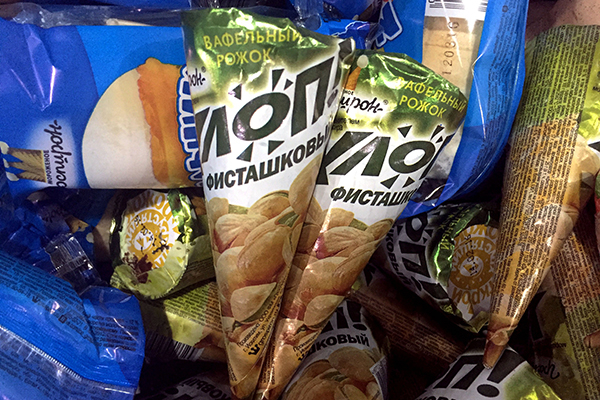Home>Biz updates
Russian commodities a hit in China
Updated : 2019-06-18
By ( chinadaily.com.cn )

Russian ice cream sold in Harbin. [Photo/China Daily]
Vodka, ice cream, flour and soybean oil -- commodities from Russia are all the rage among a large number of visitors to the ongoing China-Russia Expo held in Harbin, capital of Northeast China's Heilongjiang province.
One of the most sought-after Russian specialties at the expo is a type of chocolate candy made by Russia's KDV Group. In China, the confectionery is widely known as "purple candies" because of its distinctive purple wrappers.
Purple candies have been catching on in China as many Chinese post photos and videos of them tasting the sweets on social network platforms and short video platforms.
"My friends told me purple candies are very popular on the internet, and they do taste good," said Harbin resident Wang Xin, who bought four packets of the candies at the expo. "I've often heard people say Russian products are cheap and of good quality."
For Lyu Wei, chairman of a trading company in Heilongjiang, the huge popularity of purple candies was unimaginable when his company started importing the product in 2014.
"Our import volume was very small at the beginning. We never expected purple candies to become such a hit in China," Lyu said.
In 2015, Lyu's company sold about 2,000 metric tons of purple candies to customers across China. The number skyrocketed to nearly 20,000 tons last year, which brought in revenue of more than 400 million yuan ($58 million).
"Many customers bought the candies to treat guests during traditional Chinese festivals, which are usually the busiest times for our company," Lyu said, adding that his company would receive more than 40 containers of purple candies each day during the busy season.
Song Kui, president of the Contemporary China-Russia Regional Economy Research Institute in Heilongjiang, said the popularity of the purple candies in China is indicative of the latest trend of Sino-Russia bilateral trade.
"Agricultural products and other foods now constitute a larger share of Sino-Russia trade, reflecting significant changes in the trade structure," Song said. "In this context, Sino-Russia trade is bringing benefits to more people in the two countries."
Official data showed the bilateral trade volume between China and Russia last year exceeded $100 billion, a record high. In particular, trade of agricultural products rose 31 percent year on year in the first 11 months of 2018.
Song's view is echoed by Lyu. "Purple candies have stood witness to the development of Sino-Russia trade," he said.
Lyu's company specialized in importing Russia's engineering machinery, wood and steel in the 1990s, but its focus has now been switched to bringing a variety of Russian foods to more Chinese tables.
Lyu added that infrastructure construction in recent years has facilitated cross-border trade between China and Russia. He expected that the first highway bridge connecting the two countries, which is under construction, would further boost trade and people-to-people exchanges.

Harbin ramps up childcare services
A new comprehensive service center for childcare in Harbin is expected to be finished by the end of the year.
-
Talent policies drive enterprise development in Harbin
Harbin's "30 New Talent Policies" represents an iterative upgrade to the talent policy system, helping attract and retain talent to bolster economic and social development.
-
Official website of 2025 Asian Winter Games goes live
Harbin, the host city of the 9th Asian Winter Games, has announced that the official website for the 2025 event has recently gone live.
-
Harbin launches measures to facilitate more foreign trade
In the first three quarters of 2023, the total import and export value of Heilongjiang province's goods trade hit 218.22 billion yuan.





